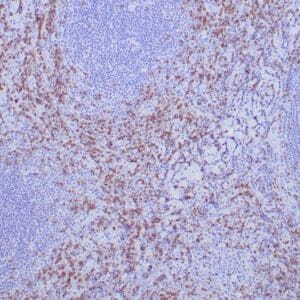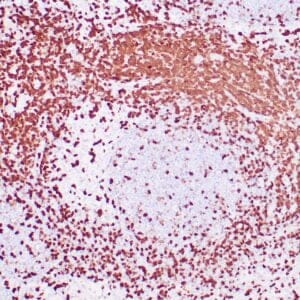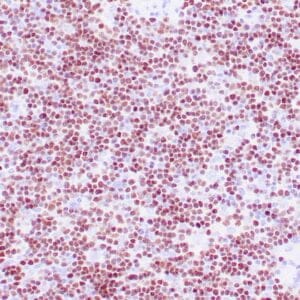| Weight | 1 lbs |
|---|---|
| Dimensions | 9 × 5 × 2 in |
| host | mouse |
| isotype | IgG |
| clonality | monoclonal |
| concentration | concentrate, predilute |
| applications | IHC |
| reactivity | human |
| available size | 0.1 mL, 0.5 mL, 1 mL concentrated, 7 mL prediluted |
rabbit anti-LEF1 monoclonal antibody (ZR336) 6241
Price range: $160.00 through $528.00
Antibody summary
- Rabbit monoclonal to LEF1
- Suitable for: Immunohistochemistry (formalin-fixed, paraffin-embedded tissues)
- Reacts with: Human
- Isotype:IgG
- Control: CLL/SLL
- Visualization: Nuclear
- 0.1, 0.5, 1.0 mL concentrated, 7 mL prediluted
rabbit anti-LEF1 monoclonal antibody ZR336 6241
| target relevance |
|---|
| Protein names Lymphoid enhancer-binding factor 1 (LEF-1) (T cell-specific transcription factor 1-alpha) (TCF1-alpha) |
| Gene names LEF1,LEF1 |
| Protein family TCF/LEF family |
| Mass 44201Da |
| Function FUNCTION: Transcription factor that binds DNA in a sequence-specific manner (PubMed:2010090). Participates in the Wnt signaling pathway (By similarity). Activates transcription of target genes in the presence of CTNNB1 and EP300 (By similarity). PIAG antagonizes both Wnt-dependent and Wnt-independent activation by LEF1 (By similarity). TLE1, TLE2, TLE3 and TLE4 repress transactivation mediated by LEF1 and CTNNB1 (PubMed:11266540). Regulates T-cell receptor alpha enhancer function (PubMed:19653274). Required for IL17A expressing gamma-delta T-cell maturation and development, via binding to regulator loci of BLK to modulate expression (By similarity). Acts as a positive regulator of odontoblast differentiation during mesenchymal tooth germ formation, expression is repressed during the bell stage by MSX1-mediated inhibition of CTNNB1 signaling (By similarity). May play a role in hair cell differentiation and follicle morphogenesis (By similarity). {ECO:0000250|UniProtKB:P27782, ECO:0000269|PubMed:11266540, ECO:0000269|PubMed:19653274, ECO:0000269|PubMed:2010090}.; FUNCTION: [Isoform 1]: Transcriptionally activates MYC and CCND1 expression and enhances proliferation of pancreatic tumor cells. {ECO:0000269|PubMed:19653274}.; FUNCTION: [Isoform 3]: Lacks the CTNNB1 interaction domain and may therefore be an antagonist for Wnt signaling. {ECO:0000269|PubMed:11326276}.; FUNCTION: [Isoform 5]: Transcriptionally activates the fibronectin promoter, binds to and represses transcription from the E-cadherin promoter in a CTNNB1-independent manner, and is involved in reducing cellular aggregation and increasing cell migration of pancreatic cancer cells. {ECO:0000269|PubMed:19653274}. |
| Subellular location SUBCELLULAR LOCATION: Nucleus {ECO:0000255|PROSITE-ProRule:PRU00267}. Note=Found in nuclear bodies upon PIASG binding. {ECO:0000250}. |
| Tissues TISSUE SPECIFICITY: Detected in thymus. Not detected in normal colon, but highly expressed in colon cancer biopsies and colon cancer cell lines. Expressed in several pancreatic tumors and weakly expressed in normal pancreatic tissue. Isoforms 1 and 5 are detected in several pancreatic cell lines. {ECO:0000269|PubMed:19653274}. |
| Structure SUBUNIT: Binds the armadillo repeat of CTNNB1 and forms a stable complex. Interacts with EP300, TLE1 and PIASG (By similarity). Binds ALYREF/THOC4, MDFI and MDFIC. Interacts with NLK. Interacts with DAZAP2 (PubMed:19304756). {ECO:0000250|UniProtKB:P27782, ECO:0000269|PubMed:12192039, ECO:0000269|PubMed:12556497, ECO:0000269|PubMed:19304756, ECO:0000269|PubMed:9119228, ECO:0000269|PubMed:9488439, ECO:0000269|PubMed:9751710}. |
| Post-translational modification PTM: Phosphorylated at Thr-155 and/or Ser-166 by NLK. Phosphorylation by NLK at these sites represses LEF1-mediated transcriptional activation of target genes of the canonical Wnt signaling pathway. {ECO:0000269|PubMed:12556497}. |
| Domain DOMAIN: Proline-rich and acidic regions are implicated in the activation functions of RNA polymerase II transcription factors. |
| Target Relevance information above includes information from UniProt accession: Q9UJU2 |
| The UniProt Consortium |
Data
 |
| Human tonsil stained with anti-LEF1 using peroxidase conjugate and DAB chromogen. Note nuclear staining of subset of B cells. |
Publications
Warning: Cannot modify header information - headers already sent by (output started at /www/benchmarkantibodiescom_769/public/wp-includes/script-loader.php:3015) in /www/benchmarkantibodiescom_769/public/wp-content/plugins/shortcode-manager/shortcode-manager.php(453) : eval()'d code on line 3
Publications
| pmid | title | authors | citation |
|---|---|---|---|
| We haven't added any publications to our database yet. | |||
Protocols
| relevant to this product |
|---|
| IHC |
Documents
| # | SDS | Certificate | |
|---|---|---|---|
| Please enter your product and batch number here to retrieve product datasheet, SDS, and QC information. | |||
Only logged in customers who have purchased this product may leave a review.















Reviews
There are no reviews yet.